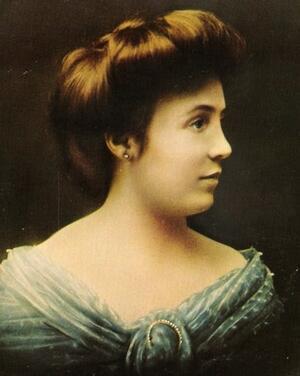Lane Bryant Malsin
Lena Bryant Malsin revolutionized the clothing industry with her classy maternity wear and clothes for plus–size women. Married young and soon widowed with an infant son, she turned to sewing expensive lingerie and bridal sets, earning enough to open her own store in 1904. When she opened her first bank account, a clerical error changed the company name to Lane. She remarried in 1909 and her second husband, Albert Malsin, managed the booming business while Lena, serving as vice president and director, focused on designs. By 1923, the business was earning $5 million in annual sales. She offered a free wardrobe to any customer whose clothes were destroyed in a disaster and donated clothes to the needy in Europe after World War II.
Lane Bryant Malsin was a fashion entrepreneur and pioneer in the best sense of the word, long before Donna Karan or Liz Claiborne. She pioneered niche marketing and mail-order merchandising, as well as innovative work practices and progressive advertising.
Early Life and Family
Born Lena Himmelstein in Lithuania in 1879, she came to the United States alone at age sixteen and supported herself as a seamstress, beginning at the weekly wage of one dollar. She soon earned the unusual wage of fifteen dollars per week because of her excellent skills. She married David Bryant, a Russian jeweler, who died shortly after their son, Raphael, was born. She supported both herself and her child with her work as a seamstress. Her specialty was lingerie and bridal sets, and she had earned enough by 1904 to open a store with living quarters in the rear. Lena became Lane because of an error when she first opened a bank account.
One of her early innovations was a garment that was used for maternity wear. While proper women were not seen on the street when pregnant, one of her clients asked her to design a garment she could wear in public—“something presentable but comfortable.” This garment, with an elasticized waist and an accordion-pleated skirt, was an instant success and soon became the store’s major product.
She remarried in 1909, and her husband, Albert Malsin, became her business partner. They had two children—a son, Theodore, and a daughter, Helen. Lane Bryant Malsin concentrated on the design aspects of the business, while her husband took over the business aspects of the firm, which by 1909 had an annual income of over fifty thousand dollars. While maternity garments were a major source of sales, no newspaper would advertise such a garment. In 1911, the New York Herald was induced to accept an advertisement, and the business’s entire stock was sold out the next day.
The partnership of Lane Bryant Malsin and her husband Albert produced other retailing innovations. They introduced sales of maternity garments by mail and, in 1911–1912, produced a thirty-two-page catalog. In 1916, the business was incorporated as Lane Bryant, Incorporated; by 1917, the company’s sales exceeded one million dollars.
Lane Bryant, Incorporated
Lane Bryant, Incorporated, also introduced clothing for the stout figure. Since no ready-made garments were on the market for this customer, Lane Bryant Malsin and her husband measured some forty-five hundred individual customers in the store and utilized other statistics on about two hundred thousand women to determine three general types of stoutness, then designed clothes to fit them. By 1923, the large-size business had surpassed the maternity wear, accounting for more than half of the annual five million dollars in sales.
Lane Bryant Malsin was vice president and director of the firm until her death on September 21, 1951. Raphael was president while her other son, Theodore, was secretary of the concern. At the time of her death, the company that bore her name was the sixth-largest mail-order business in the country. The retail stores, which began with a branch in Chicago in 1915, had also expanded rapidly. By 1969, the firm consisted of more than one hundred stores and affiliates, with sales of almost two hundred million dollars. The firm has since been purchased by The Limited and has been integrated into this organization.
Lane Bryant Malsin was also a pioneer in terms of employee relations and customer focus. Prior to her death, the company’s thirty-five hundred employees participated in a profit-sharing plan and a pension plan that included protection against permanent disability, free hospitalization, group life insurance, and sickness insurance. This was at a time when neither plan was a common practice, particularly in the retail industry. An initial stock offering also included a 25 percent employee subscription.
In terms of customer focus, any Lane Bryant customer whose wardrobe was destroyed in a disaster was offered a free wardrobe through the American Red Cross. In 1947, after a major explosion and fire in Texas City, Texas, fifty-eight mail-order customers were reattired. In addition, after World War II, the Lane Bryant stores became centers for donations of clothing to Europe’s needy. Lane Bryant Malsin was also active in the American Red Cross, the Hebrew Immigrant Aid Society, and the Federation of Jewish Philanthropies.
Lane Bryant Malsin also represents the immigrant worker who, through her own initiative, rose from poverty to wealth, but who did not forget those less fortunate than herself. She combined career, marriage, and motherhood at a time when marriage often marked the end of paid work. She demonstrated, through a life of innovation, hard work, and care for others, a Jewish consciousness and an appreciation for others’ needs.
EJ,
Fucini, Joseph J., and Suzy Fucini. Entrepreneurs: The Men and Women Behind Famous Brand Names and How They Made It (1985).
Mahoney, T. “Independent Woman. ” Americana Annual (1952): 431–432.
National Cyclopaedia of American Biography. Vol. 47 (1965).
Obituary. NYTimes, September 27, 1951, 31:1, s.v. “Malsin, Lane B.”.
O’Neill, Lois Decker, ed. The Woman’s Book of World Records and Achievements (1979).
World Almanac Biographical Dictionary (1990).




